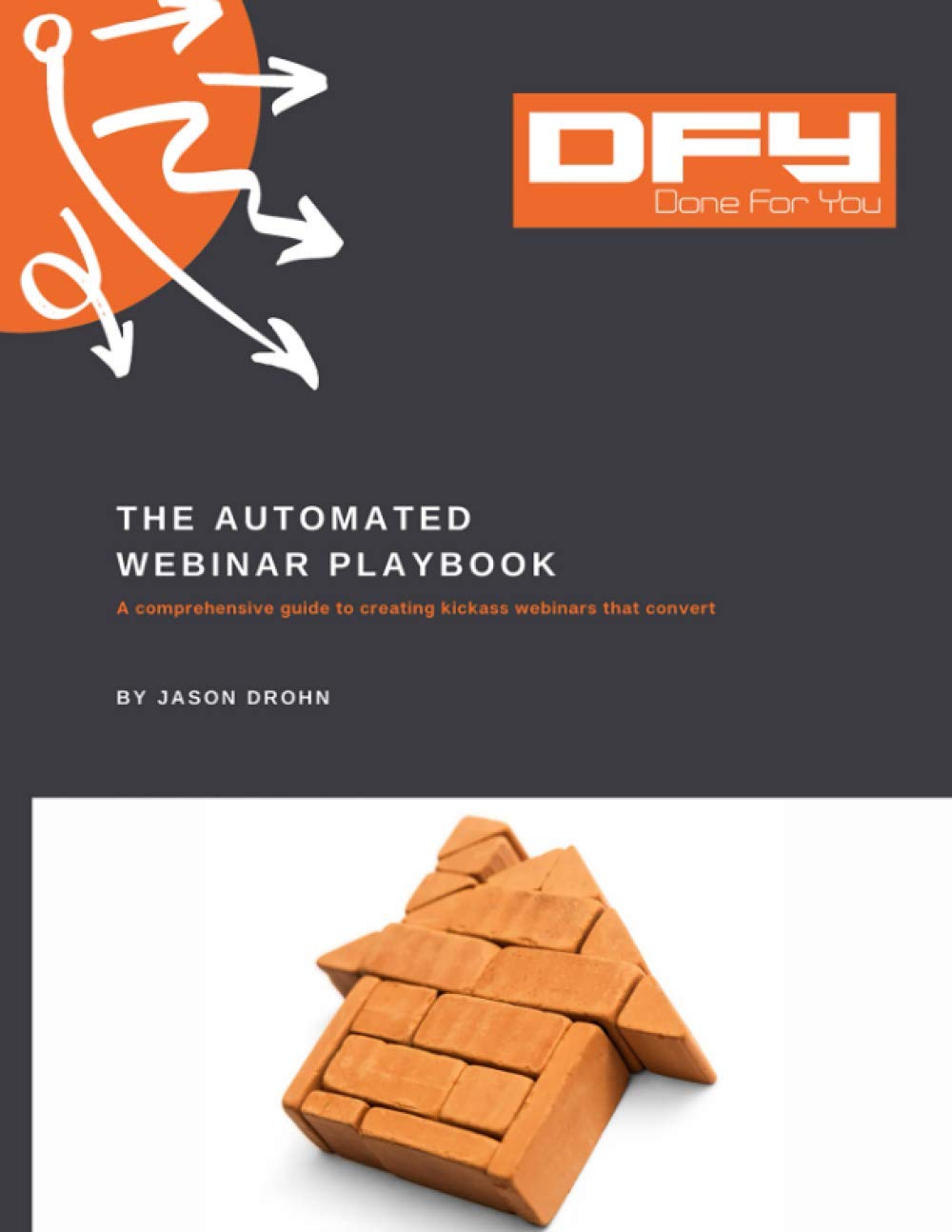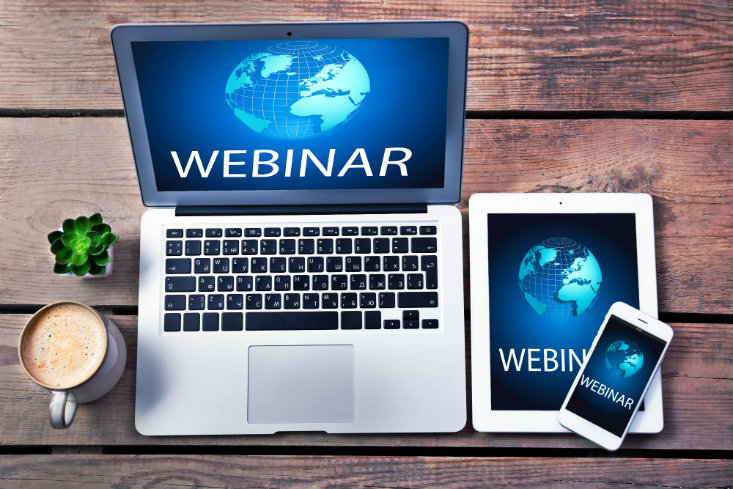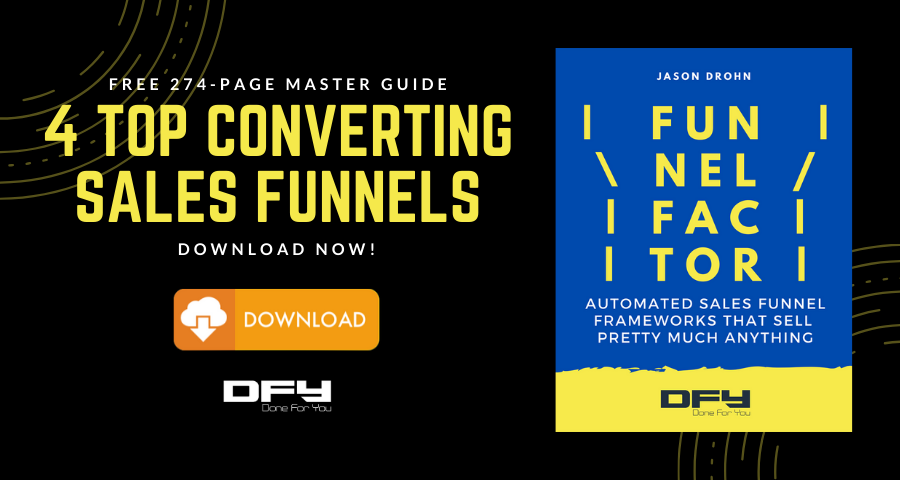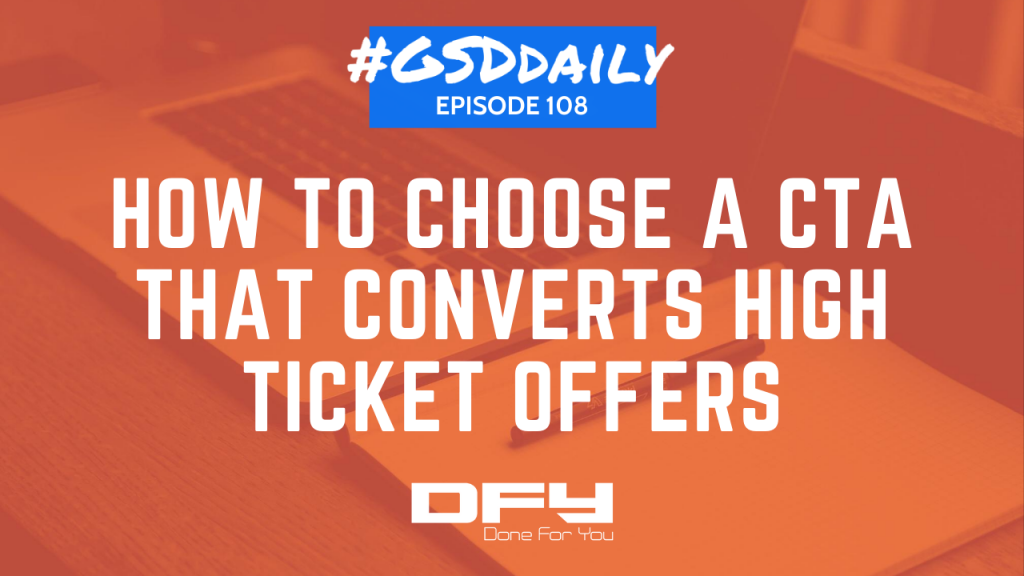In today’s GSDdaily, we’re going to talk about picking the right call to action for your webinar. We’re also going to talk about the tools and tech and gear and stuff that you need to pull off a webinar that you can sell high-ticket products and services on. This entire week we’ve been going through this, which is a PDF that we put together on, the Automated Webinar Playbook. You can get this thing for free at… I’m going to change this little ticker here, so download PDF at, there we go. All right. You can go ahead and download this PDF for free at doneforyou.com/legendary.

Now, the reason it’s legendary is this is our L1 funnel, which is basically, it’s a high-ticket automated webinar funnel and it walks through the exact process of creating something automated that sells for you. It sells your coaching program, your consulting program, your high-ticket digital product, your lead magnet, or not lead magnet. Sometimes you need a lead magnet, but it sells all that stuff for you. In the last couple of days, we’ve been walking through this guide. Yesterday we talked about this, where is it? Right there, we went through this sales funnel process. And then we went through this piece, which was the checklist on all of the material that you need to pull off one of these funnels. So that was yesterday’s thing.
Maximizing the Conversion of High Ticket Offers
Today what we’re doing is we’re talking about maximizing the conversion of our high ticket offers. We’re going to walk through the next probably 10 or so pages of this guide, but when it gets to maximizing the conversion of high ticket offers, your webinar does a lot of work. I call it the triple trigger.
Webinar
Your webinar helps you generate leads and you’re generating leads to cold traffic or warm traffic or your email list. You’re getting people to raise their hand and say, “Yes, I’m interested in the thing that you were offering,” or “I’m interested in the challenge that you’re presenting and the challenge you’re going to be solving on the webinar.” “Yes, I am interested in transforming my business or myself into that thing that you’re going to be educating on.” That’s what registering for a webinar means. Now that makes the webinar an awesome lead-generation tool, if nothing else, but webinars do so much more than that which will be your high ticket offers.
You usually have webinars anymore a little bit shorter. They’re don’t go for 90 minutes like they did five or six years ago. Most webinars are 30, 45, or 50 minutes kind of it tops out at. Your webinar really generates a lead. It engaged in bonds with a prospect. What you’re doing is kind of compressing that whole awareness, interest, desire, action, you’re compressing it into a 60-minute chunk of time. You’re getting awareness from the prospect. They are becoming interested in the thing that of your high ticket offers. They find themselves desiring the thing, hopefully, if they’re the right customer avatar and all that stuff. Then they take action on it. It’s this compressed block of time that you’re going to get somebody engaged, interested in taking action. The last piece is the call to action.
Now in maximizing the conversion of high ticket offers, there’s a couple of things you have to take into consideration.
The first is who is your target avatar? Are they a busy executive who was in no way going to ever schedule something on their calendar, like an hour block of time for a web-based presentation? They’re going to have one of their underlings do it. If that’s the case, then you need to engage with them immediately. On-demand. And sometimes you need to engage with them with a PDF first, showcasing your ability and then inviting them to the webinar. Others, very aspirational markets like business development, business opportunity, a lot of times you can schedule that webinar out in advance and people are going to sign up for it. But the key to maximizing your conversion of high ticket offers on the webinars is presenting the right call to action that matches up with the prospect.

The Framework of Successful Webinar
Here’s kind of the framework of the successful webinar. In most markets, in most niches, the call to action should drop around 45 minutes. So part of then is because when somebody blocks out time for a webinar, they usually block 60 minutes. What you want to do is you want the call to action to land about 40, 45 minutes in, and then have some time to decompress from there. Answer some questions, maybe drop a couple of testimonials, whatever. You want to have a very brief intro section. I tell a lot of our clients the biography and the introductory part of the webinar needs to be this big in comparison to the whole webinar. People don’t care about you. They don’t care about who you are and what you can do for them. All they care about the problem that you’re going to solve for them.
They don’t necessarily care about who you are until after they learned about the solution. So it’s important to introduce yourself because that’s just good manners. But, at the same time, don’t spend a whole lot of time talking about your accolades and your education and your experience and your history, because most likely it doesn’t matter yet. It will matter afterward. It matters after you showcase your ability, but not right now. So the bio can be real short, then you talk about the solution, and then you can even get into your story or how it ties in with your story or whatever, but you need to deliver value.
We always use questions in our webinar and that is to engage the audience thinking, to engage the thinking of the audience. And here’s why. Whenever you’re asked a question, your brain answers that question, regardless of if you kind of consciously come up with the answer yourself. Whenever you posed with a question, your brain answers it, which is it engages it. Sometimes that comes up to the conscious level, where you can verbalize your answer, but if you’re asked a question, your brain’s going to answer it. So that’s why we use questions. It engages folks. It aligns with their thinking. And a lot of the times what we do, we do three successful questions and they start very broad, you can think of it as a funnel that will be your high ticket offers.
Start very broad and then the next question is a little bit more narrow. And the next question is even more narrow. And that last question is what sets up the rest of the presentation. Then what you do is you move to content for like 20 or 30 minutes. You talk about your four-step system or five hacks or six questions or six secrets or whatever. And then you transition them into the pitch. And that’s where the call to action comes in. So the call to action itself is… There’s an art in moving from good content to a good call to action. And we always try to make it as seamless as possible.
We try not to make it real abrupt. Now we’ve covered and there’s so much more to cover other than this, but all we have is 45 minutes in this presentation. So what I did was blah, blah, blah, blah, blah. I put together a coaching program where it’ll reveal the secrets of the universe and you can have access to blah, blah, blah money.
It needs to be more elegant than that, so we try to have a nice transition between the content and how that content that they just learned can be further reinforced or further accelerated by the high ticket offers. So that tends to work pretty well. And then right here in the PDF is some notes that you can take as you kind of go through it. And choosing a call to action that matters. This is kind of what the whole high-ticket webinar thing is all about. The call to action you need when you are selling high ticket offers is a strategy session. So the call to action is going to be signing up, booking a call on your calendar or your team’s calendar, your sales rep’s calendar, whatever. So the webinar sets up the sale, but it doesn’t sell the thing.
The webinar sets up the sales call and the sales call sells the thing. And the sales call is only effective if the high ticket offers are great for both sides, meaning the prospect gets something solved that they need to have solved, the solution for their problems, and then, of course, you or your company are providing the solution and you’re happy about the client, or you’re happy about the project too. So that’s one of the best ways to maximize conversion to high ticket offers.
What I usually tell my clients is when you have a webinar that is set up like this, where it’s a webinar that goes into a strategy session call, typically you’re going to close like one in four when you’re first starting. Because the webinar, if it’s doing its job is kind of talking about the high ticket offers, talking about the problem, talking about the solution. Just the fact that somebody went through that webinar and then ultimately booked the call and then answer some questions on an application.
Then we know that they’re going to be a good fit or not a good fit. And if they’re not a good fit, don’t even waste your time on the call. So you don’t have to, if you don’t want to, you know what I mean? So give him a call. Have a great call. Sometimes it’ll be a one-call close or two call closes or three call close or whatever. But as long as you’re serving your prospect, then you’re going to close some sales. As far as the tools.
The benefits beyond sales, first of all, you build your email list because your webinars are great lead-generation tools, you’re selling more of your product or service, and you’re also connecting with your audience in a way that is different than just a kind of a cold website. So those are three of the biggest benefits that you get out of this webinar. Now, the tools that you’re going to need.

Tools to Conduct Webinars
So the tools in tech have changed a little bit. A little bit, but not much. There are so many things now, especially now, like mid-pandemic, that we’ve been shoved into needing to use. We’ve had to figure them out. Not us, we’ve been using it forever but now the population is just a whole lot more comfortable with Zoom. Everybody has webcams. Everybody knows how to do video through their computer, for the most part, and if they don’t know how to do it, video through the computer, they know how to do it through their phone.
As a global population, we’ve all figured out the video to a much better degree. That makes your job infinitely easier now. Here are some of the mics that we use. It’s totally up to you if you want to use this stuff. I used to always say that like Apple’s tools, Apple laptops, and stuff, the camera and stuff were great. They’re not so much anymore. I guess this new line of MacBook Pros and stuff that are coming out, they’re going to have like full 4K cameras or at least 1080 cameras.
Microphone
The two pieces of equipment you’re going to need is a microphone. There are some examples here.
- Blue Snowball
- Blue Yeti
- Audio-Technica AT2020
You can find blue snowball and blue yeti at Best Buy. You can also order them online. I use these. This is an Audio-Technica AT2020. They have a USB variant and then also a music recording variant. I don’t know if I can share this. Of course, it’s kind of short, but that cord right there. I don’t know anything about recording music, but I do know that this is a I think it’s an XLR cord and then it pipes into a mixer. So that’s what I use. I have an AT2020 on my desk over there too. A USB variation.
Camera
- Logitech HD Pro
That way we have a uniform recording on videos and stuff. The Logitech HD Pro, this camera, has been nice. I have been using something different though. This is an actual 1080 camera that pipes into a USB connection on the computer, which is sometimes why I have issues with their video. It works, but the setup was kind of created for gaming. Then I have the same thing over on that computer there. There are some lights now. These lights, super-nice, but now they have LED variations. There’s a light there, which is the same as this light here. I have one that kind of sits. You can see it on my glasses.
Now you’re not going to be able to unsee it. But so we have one of these lights and then I have like a ring light over on that computer, which helps out quite a bit too. And let’s see, that’s it for tools. And then software. Here, let me show you these though. Let me pull up a web browser page because I want to show you kind of what I have been using from a camera set up.
This is a camera set up that I have been using. You can see that I last purchased this thing on April 28th. So I have two of these cameras. Well, so what happened was is I would have just bought two webcams, but with the pandemic, everybody started buying webcams. So I was looking around and as a good solid brand-name webcam was $189. And I was like, “Well, shit, why don’t I just buy a camcorder, and then I can use it for other stuff if I want to?” So I ended up grabbing two of this camcorder. One for this, and this is what I’m looking at now, and then another one over there, which is what, when I’m like at my sitting desk, is what I use. And then I got an HDMI-to-USB adapter.
It’s, basically, one of these things. Now there are lots of different variations of this. And a lot of them are from China. It just depends on the kind of what you want to go with. I ended up going with, let’s see the brand of the one that I have, a HornetTek video capture. HornetTek, H-O-R-N-E-T… there it is.
This is the one that I grabbed. I have two of these and what it is is it’s an HDMI cable on one side and USB out of the other side. So it’s a passive device. A lot of gamers use it. What they do is they use an HDMI splitter and then one side goes to their TV and the other side goes to their computer so that they can stream shit on Twitch or whatever. I think that’s how it works. I’m not 100% positive. But just in reading the reviews, I saw that a lot of people were doing just that. There are all kinds of others… I think there’s one called an Elgato, which is one that I read about quite a bit. But there are lots of different kinds of video capture tools.
This is just what I’ve been using. Do you have a camcorder that outputs HDMI, then you can use one of these things and get a great camera resolution on it. And then we talked about mics. So those are probably the two most pivotal things. I also have one of these. Sling Studio. I think it’s at myslingstudio.com. Yeah. So I have a Sling Studio too that I record. And it’s a video-camera switching unit. So you can record anything on iOS. You can have an iPhone, iPad always recording inputs as well as these, which is pretty cool for camera switching. I don’t do it on the live streams, but I do on some of the other videos. So just a couple of things from a webcam standpoint.
Now, when we get to webinar software, there are so many different types of webinar software out there that will help you do these webinars. From a tried-and-true standpoint, GoToWebinar is nice. I have been a GoToWebinar user forever, but I do have to say that I switched to Zoom for so many more things, just because it’s easier. GoToWebinar, you don’t need to download software or Zoom you don’t need to download the software. You send a link and everybody just has it. GoToWebinar, I found that so many people were using Zoom that now GoToWebinar and GoToMeeting, having to download stuff for the conferencing, which was just a pain in the ass. And so we stopped using it. We moved over to Zoom.
In terms of automated webinar stuff, there’s EverWebinar is still the best. EverWebinar. Great tool from a marketing standpoint. Let’s see. And those are kind of pretty much the only tools that we use from a webinars standpoint. Any more though, literally, on Monday, we talked about the on-demand webinars, which is pretty much all we do anymore. So it’s, basically, a landing page that kicks over into a webinar room page. The webinar room page is set to have a video that automatically starts. So it’ll, the webinar room page, the video just automatically goes live. And then there’s a webinar replay page that has a call to action button underneath it. So we don’t even use special software for it anymore. We just use a Vimeo web player that shows up.
Let’s see. And I think, for the most part, that’s about as far as we were going to get in this guide today. Email marketing software. For the most part, we use like ActiveCampaign or we use our CRM, which is access or we’ll use like InfusionSoft or Keeper and Ontraport. Those are pretty much the email. So if somebody opts in for the webinar, they get the email through those email marketing platforms and we tie all that stuff in, and then the webinar gets delivered from there. I’ve got some stuff on webinar tools. All right.
I think probably the last thing we need to talk about, and we kind of touched on it yesterday, which is just all the different emails that you need to pull this thing off. So you need the webinar promo emails, the emails that go out promoting the webinar. You need the webinar replay emails. So that is the emails that go out after somebody attends the webinar and those emails promote the webinar. They promote high ticket offers. If this is an evergreen webinar, you can do evergreen webinar promo and evergreen replay emails.
That’s really about it from an asset standpoint. You need a sales presentation too. You have to do the webinar slides to have the webinar. Then we have a little checklist here – microphone, your camera, your lighting, the webinar software. What are you going to use for that? What are you going to use for email marketing? Then what sequences are you going to run? If you have any notes, go ahead and write to them there.
For Questions and Guide
If you have questions on putting the whole thing together, go to doneforyou.com/start, fill out the little application and jump on a call with us. We’ll go through an action plan for you, with you.
I want to talk about your funnel, your traffic, the webinar set up, and all that stuff. And I will see you tomorrow. Tomorrow we’re going to get into the replay, which is the replay and the replay email sequence. Probably 85% of your sales are going to come from the replay. It’s a bigger part of the high-ticket sales system than the webinar itself, is the replay. We’ll cover that tomorrow and I will talk to you soon.

